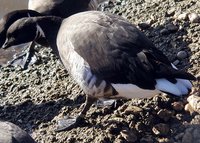Brent Goose
|
|
| Brent Goose Conservation status: Secure | ||||||||||||||
|---|---|---|---|---|---|---|---|---|---|---|---|---|---|---|
 Pacific Brant Goose (or Black Brant) | ||||||||||||||
| Scientific classification | ||||||||||||||
| ||||||||||||||
| Binomial name | ||||||||||||||
| Branta bernicla Linnaeus, 1758 |
The Brent Goose (Branta bernicla) is a goose of the genus Branta, known in North America as Brant. The spelling "Brant" is the original one, with "Brent" being a later folk-etymological idea that it was derived from a classical Greek waterbird name brenthos. It is in fact onomatopoeic, derived from the guttural call note of the species.
The Brant Goose is a small goose, about 60 cm long and with a short, stubby bill; overall it is blackish-brown and white in colour, the pattern depending on the race. The under-tail is pure white, and the tail black and very short (the shortest of any goose), in all the races. There are three or four races; these are considered by some to be species, though the evidence for speciation is weak, with all the races mixing freely and interbreeding readily where opportunity permits.
The nominate race, Dark-bellied Brant (B. b. bernicla) breeds on the Arctic coasts of central and western Siberia and winters in western Europe, with over half the population in southern England, the rest between northern Germany and northern France. The body is fairly uniformly dark grey-brown all over, the flanks and belly not significantly paler than the back. The head and neck are black, with a small white patch on either side of the neck.
The Pale-bellied Brant (B. b. hrota) of Franz Josef Land, Svalbard, Greenland and northeastern Canada, wintering in Denmark, northeast England, Ireland and the Atlantic coast of the U.S. from Maine to Georgia. It differs in much paler underparts and flanks, contrasting with the dark grey back. The head and neck are as in the nominate race.
The Black Brant (B. b. nigricans) breeds in northwestern Canada, Alaska and eastern Siberia, and wintering mostly on the west coast of North America from southern Alaska to California, but also some in east Asia, mainly Japan. It is a more contrastingly black and white bird than the other races, with the underparts black at the front, grading to white at the rear; it also has larger white neck patches, forming a near-complete collar.
A fourth form, Gray Brant or Intermediate Brant, is either a subspecies or an intergrade population between the Pale-bellied and Black; it breeds in central arctic Canada (mainly Melville Island), and winters in the Puget Sound on the American west coast near the U.S./Canada border.
The Brant at least used to be a strictly coastal bird in winter, seldom leaving tidal estuaries, where it fed on eel-grass (Zostera marina) and a type of seaweed, sea lettuce (Ulva). In recent decades in Europe, it has started using agricultural land a short distance inland, feeding extensively on grass and winter-sown cereals. This may be behaviour learnt by following other species of geese. Food resources pressure may also be important in forcing this change, as the European wintering population has risen over ten-fold between 1950-2000, possibly exceeding the carrying capacity of the estuaries.
In the breeding season, they use low-lying wet coastal tundra for both breeding and feeding. The nest is bowl-shaped, lined with grass and down, in an elevated location, often in a small pond.
For the origin of the scientific name bernicla see Barnacle Goose.
Template:Commonsbg:Черна гъска da:Knortegås de:Ringelgans eo:Kolringa ansero lt:Paprastoji berniklė nl:Rotgans pl:Bernikla obrożna
